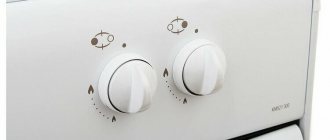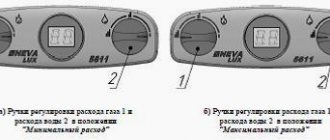The water heater is gradually becoming one of the indispensable things that are found not only in country houses, but also in comfortable apartments. Modern manufacturers supply high-quality products to the market, because competition is high. Oasis gas water heaters are very popular among consumers, reviews of which you can read below.
This equipment belongs to the middle class and skillfully combines reasonable cost and decent quality. In order to choose a suitable model, you need to pay attention to the characteristics of the models, their positive and negative sides.
The main types of speakers from
Water heaters are classified according to their operating principle. Products can be flow-through or storage. These units have different heating mechanisms. Flow columns are the most common today. With their help, you can get stable and constant heating of water, and pressure will not affect this.
Instantaneous water heaters are classified by performance. In one minute you can get from 6 to 13 liters of heated water. Gas water heaters "Oasis", reviews of which should help you make the right choice, also differ from each other in power.
Frequent malfunctions and their elimination
Before you start troubleshooting the Oasis brand column and choosing a solution, you need to make sure that there is normal water pressure in the system and draft in the chimney. It is better to check the draft with a candle or match; the flame should deviate well until it extinguishes.
Let's consider the most common malfunctions that appear during the operation of Oasis speakers, possible causes of their occurrence, and methods of elimination.
Problem #1 - the flame in the burner does not ignite
If the Oasis gas water heater does not light up, there may be several main reasons. Let's talk about the main ones.
Insufficient power supply to the speaker
Insufficient power supply or no power supply. The most likely and simplest reason for this malfunction lies in dead batteries . If, when you open the tap, you hear a discharge crackling sound, there is a spark, the pressure is normal, but the gas does not ignite, then the reason is most likely in the batteries.
Over time they lose their capacity. Their power drops, they cannot supply the required current to the load. It is only enough to start a high-voltage generator, and there is not enough power to open the solenoid valve.
Deterioration of contacts in the battery compartment due to corrosion and contamination can also cause ignition problems. Corrosion can be caused by leaking batteries or moisture entering the contacts from the outside.
Remedy: replace the batteries with new ones. Alkaline elements should be installed. First you need to check the condition of the contacts. If necessary, wipe them with alcohol, or clean them with sandpaper, a knife or a file. If corrosion damage occurs as a result of moisture ingress, the source should be identified and the leak repaired.
For chimneyless speakers, the lack of ignition may be due to a malfunction of the mains power supply . Only in this case there will be no spark discharge.
Weak pressure at the water heater outlet
Deterioration of water flow through the column is a common occurrence.
If the water pressure in the system is normal, but the outlet of the column is weak, then there may be several options:
- the filter at the inlet of the water block is clogged;
- the throughput of the heat exchanger coil is impaired due to scale;
- the mesh divider (aerator) on the hot water tap is clogged;
- a piece of scale got into the flexible hose supplying hot water to the tap.
Remedy: remove, clean, rinse mesh filters under running water. Replace flexible hose. Clean the heat exchanger.
If there is salt deposits on the filter, it is necessary to boil it in a 10% citric acid solution for 15 minutes
Water unit malfunction
Under the pressure of the incoming water flow, the membrane pushes the rod, which opens the mechanical gas valve and presses the microswitch button that activates the ignition.
This mechanism may fail for the following reasons:
- the membrane is worn out, over time it loses its properties, elasticity, and breaks;
- the rod is stuck.
Remedy: disassemble the water unit. If the threaded connections are stuck, treat them with anti-corrosion agent WD-40 or brake fluid and leave for half an hour. Then replace the membrane, lubricate the rod, spring and seal. It is better to install a new silicone membrane; it will last longer.
Malfunction of microswitch or solenoid valve
You can check the serviceability of the microswitch and solenoid valve with a multimeter. To do this, it must be switched to resistance measurement mode with a minimum limit. Connect the probes to the microswitch terminals and alternately press and release the button.
If the readings of the device vary from one ohm to infinity, then the switch is most likely working. If the readings do not change, the microswitch is faulty.
To check the solenoid valve, you need to measure the resistance of the solenoid windings at the connector terminals. It should be about 400 ohms between the black and yellow wires, and the yellow and red. Between the red and black wires - about 7 ohms. If the measurement results are significantly different, the solenoid valve is faulty.
Sometimes traces of corrosion and moisture are found on the microswitch, in which case it needs to be replaced after eliminating the leak and its consequences
Remedy: these elements cannot be repaired and must be replaced.
Problem #2 - The flame comes on and goes out
This happens when the electronic unit does not receive the ignition signal, stops ignition and shuts off the gas. The cause may be a malfunction of the flame sensor or the formation of carbon deposits on the sensor.
Remedy: lightly clean the sensor with fine sandpaper (zero sandpaper). In this case, you should not be too zealous so as not to damage the metal coating. If this procedure does not produce results, the flame sensor must be replaced .
Problem #3 - the device goes out after a few minutes
This malfunction is often associated with poor traction or overheating.
Remedy: clean the chimney, reduce the water temperature by adjusting the flame and pressure, do not dilute the hot water with the mixer.
Problem #4 - column leakage
To determine the exact location of the leak, you need to remove the front panel and carefully inspect all the components of the column. The most common leak occurs in the water block or heat exchanger.
The stem seal is leaking
The water-gas unit has one design feature that is not visible in its normal position. There is a hole in the back wall through which the rod controls the microswitch lever. Leaks often occur through it when the oil seal wears out.
This feature of the Oasis geyser water block can only be seen from the reverse side when removing the unit.
To detect oil seal leaks, it is enough to inspect the mounting location of the microswitch. If there is moisture, but the top of the block is dry, it means the water unit rod seal is leaking
Remedy: remove the batteries, remove the battery installation unit. Unscrew the nuts on the inlet and outlet pipes of the water block. Disconnect the water supply pipe (hose) and radiator tube. Disassemble the water unit, replace the oil seal or the entire rod.
Radiator leak and its elimination
Heat exchangers made of copper and copper-containing alloys have the greatest risk of leakage. The reason is that manufacturers often use alloys in which the percentage of copper is lower and lower.
During operation, as a result of corrosion and mechanical damage, small holes begin to appear, violating the tightness of the radiator. These are the so-called “fistulas”. In these places, the heat exchanger begins to let water through.
By the way, even a high-quality copper heat exchanger is not protected from rapid destruction - corrosion occurs under the influence of stray currents that arise in the water supply if the column is not properly grounded or if other operating rules for gas-using equipment are violated.
When the first signs of a leak appear, you should not delay in taking action. A small seepage can soon turn into a trickle and a fountain, water will fall on other components, which can lead to their failure
Elimination: you can replace the heat exchanger with a new one, but this will cost a third of the price of the column. Often this is not justified; it is much easier to solder it without disassembling the entire column and removing the radiator.
Before you start soldering, you need to drain all the water from the radiator, otherwise heating the pipeline will be problematic. To do this, you need to turn off the water supply to the column, disconnect the incoming pipe from the pipe, place a container under it, and open the hot water tap.
When the water has drained, it is necessary to blow through to remove residues. You can use a vacuum cleaner or compressor. If such devices are not at hand, you can blow through with your mouth. To do this, you need to select a rubber hose of suitable diameter and fit it tightly onto the coil, strengthen the connection by crimping.
Soldering can be done in two ways: with a gas torch or a soldering iron.
Soldering with a gas torch
For soldering you will need a torch with a gas cartridge, a sponge, flux paste containing tin and copper, and solder.
Start by heating the leaking tube to evaporate any remaining water. Clean the soldering area with a sponge. Apply flux paste. Heat again until the flux color changes from gray to silver.
By touching the solder rod to the hot tube, ensure that the tin spreads evenly over the surface. It is important that the solder is melted not by the burner flame, but by the heated tube
To prevent flux residues from leading to corrosion, it is necessary to remove them with a damp cloth.
We provided detailed instructions on soldering copper tubes with a gas torch in this material.
Soldering the column with a soldering iron
Prepare a powerful soldering iron of 100 W or more, POS-50, POS-61 or other solder with a melting point of at least 200 degrees. Flux: rosin or solder fat, you can also use aspirin tablets. Using a hair dryer makes warming up much easier.
The soldering area must be cleaned with a zero polish until all traces of corrosion are removed from the metal surface. Then degrease it with alcohol or solvent.
Heat the soldering area well with a soldering iron. Additional heating with a hair dryer gives excellent results. Tin the soldering iron tip with a piece of solder. Apply a small amount of flux to the soldering area and immediately tin the metal surface with a soldering iron. Try to maintain the fluidity of the solder by adding flux from time to time. Bring the solder thickness to 1-3 mm.
With good heating, a thin layer of solder is enough to reliably eliminate a leak and prevent destruction of the pipeline at the soldering site.
Problem #5 - reduced pressure and low water heating
Signs of scale formation in the heat exchanger are a decrease in the flow of water at the outlet of the column and its weak heating . In this case, the column may not ignite well, and the radiator overheats due to poor heat exchange with water. This triggers the thermal protection sensor and turns off the column.
Clogged radiator fins also lead to overheating. When they become clogged with debris and scale, it becomes difficult for combustion products to exit into the chimney, which can lead to burnout of the heat exchanger skirt.
Water hardness is the main reason for the deterioration of pipeline capacity. The presence of calcium, magnesium salts and other impurities promotes scale formation and reduces heat transfer. Heating significantly enhances this process.
Scale reduces efficiency and increases gas costs to achieve the desired temperature. If measures are not taken to remove it, deposits will grow even faster, until the water flow is completely blocked.
You cannot use a column with heat exchanger tubes clogged with scale. This will lead to local overheating, cracks in the coil and the need to replace it.
Remedy: wash the heat exchanger with a special solution. There is a wide selection of reagents for professional use. They do the best job of removing scale without damaging the pipeline.
Most chemicals contain solutions of various acids. Their concentration and composition are selected in such a way as to effectively dissolve salt deposits, but act as gently as possible on the inner surface of the pipeline. The selection of a suitable reagent should take into account the heat exchanger material.
For example, reagents intended for copper radiators cannot be used for pipelines made of galvanized and stainless steel and vice versa.
The highest quality washing is done using special equipment (boosters). The effect is achieved through repeated circulation of the reagent, its heating, reverse, and the use of special compounds. The cost of such equipment, as well as services, is quite high. Purchasing boosters is more justified for professional use.
Good results can be achieved in less expensive ways using available devices and reagents.
The most popular and proven means of washing heat exchangers are solutions of citric acid, vinegar, anti-scale and other acidic cleaners. It is important to observe the dosage - exceeding the concentration of the active substance can damage the pipeline
To remove scale, 10–20% solutions are usually used. For 1 liter of water take 100 g - 200 g of anti-scale or citric acid or 9% vinegar. The greatest effect is achieved when the solution is heated to 80 - 100 degrees.
Washing can be done in two ways:
- without dismantling the radiator;
- with removal of the heat exchanger.
To flush the radiator without removing it , you have to perform a number of steps. First, turn off the water by placing a container to drain. Disconnect the outlet pipe and open the tap. Next, unscrew the nut connecting the coil to the water block. Connect a funnel from a cut plastic bottle with a flexible hose to the inlet of the coil.
Then secure the funnel above the heat exchanger. Pour the working solution into the funnel in small portions until foam appears at the other end of the coil. The procedure must be carried out for 4-6 hours until the chemical reaction stops, guided by the foam released, or using acidity indicators.
After dismantling the heat exchanger, washing is performed as follows: first disassemble the column, remove the radiator and burner. Then the plate is cleaned of soot and soot. After this, place the radiator in a large metal container with water, pour the reagent inside the pipeline and heat the container. At the end, the heat exchanger should be rinsed with cold water and a 10% soda solution.
Customer reviews about flow models
Among the positive aspects of flow equipment, buyers highlight:
- automatic switching on;
- the presence of a regulator that controls the water heating process;
- no dependence on electricity;
- opportunity to minimize costs.
As for the lack of dependence on electricity, it is ensured by operation, which is carried out using replaceable batteries. The design provides for a regulator with which you can control the heating process depending on the time of year. Consumers emphasize that flow-through models also have their disadvantages, which are expressed in the high cost of the devices. But buyers emphasize that such devices pay off in durability and practicality.
Reviews of storage columns
After reading customer reviews about Oasis geysers, you can understand that the principle of operation of storage devices is completely different. Water is heated in a special tank, which is well insulated. Consumers consider the advantages of such units to be:
- availability of a constant volume of hot water;
- comfortable operation;
- economical work.
Cumulative models, according to consumers, also have their disadvantages, they are expressed in the large size of the structures and high cost. If there is not much free space in the apartment, then placing a storage column will be quite difficult. Buyers emphasize that it is better to purchase such equipment for a spacious private house than for a small city apartment. In the latter case, some difficulties may arise with installing the device.
Despite some disadvantages, consumers quite often purchase Oasis brand products. Customer reviews of the Oasis gas water heater will allow you to verify this. According to consumer opinions, storage models can be quite compact. However, the volume of the water tank will not exceed 15 liters. For a modern small-sized kitchen, such equipment will be a real godsend.
Review of Oasis water heater models
All electric models offered under the Oasis brand can be divided into 5 lines:
- Standard;
- Plain;
- Steel;
- Small;
- Slim.
The first of them distinguishes the following models:
- "Oasis VG", supplied with tanks with a capacity of 30, 50 and 80 l;
- "Oasis VC", which is equipped with a tank with a capacity of up to 100 liters.
The Plain series also has 2 modifications. Its difference from the Standard line comes down to the installation of a double internal tank. Simultaneous distribution of water to several points is supported.
Steel modifications are made of non-magnetic stainless steel and include additional elements for installation. Representatives of the Small series differ only in tank capacity - 10 and 15 liters.
Slim water heaters differ not only in the shape of the water storage tank, but also in such properties as glass enamel coating of the tank and the presence of a safety valve.
Slim series water heaters are easy to use, reliable and durable.
Gas water heaters are presented in the following series:
- Standard;
- Glass;
- Turbo;
- Modern.
All models have a “Winter-Summer” switch, which makes it possible to save gas. Suitable for operation at reduced pressure. Automatically turn on and off when opening/closing the tap. Product lines vary in characteristics such as:
- presence of forced ejection;
- power supply of the auto-ignition system from the mains or batteries;
- Possibility to operate from gas cylinders.
Reviews of the Turbo W/TUR 20 speaker
Reviews about the Oasis gas water heater will allow you to understand whether you should opt for one model or another. W/TUR 20 is no exception. According to consumers, this instantaneous water heater is an ideal solution for providing an apartment or house with hot water.
The equipment can be installed in a room where there is no permanent chimney. You can install it autonomously, and the fundamental difference from automatic traditional models is expressed in the forced emission of combustion products.
Consumers like that there is no need to replace batteries, because the speaker runs on mains power. It is fully automatic and turns on/off when the tap is opened or closed.
Troubleshooting that prevents the gas heater from igniting
There is a turbocharged gas water heater with electric ignition. When the hot water is turned on, the heater clicks, but does not light up. An electric discharge is heard and the fan turns on.
The first step is to carry out an inspection; to do this, remove the column cover. It is fastened with four bolts: two from below, two from above. We also remove the knobs for adjusting the flame, temperature, and winter-summer mode. Upon inspection, everything seems intact, the wires are not burned anywhere, water is not leaking anywhere.
The principle of operation is that when a water flow appears, the gas valve is activated, an electric discharge is created, the gas is ignited, and at the same time the fan is turned on to draw waste combustion products outside. If the water pressure is insufficient or the hood does not work, the gas goes out and the column turns off.
So, open the tap and see what happens. Water rustled through the heat exchanger tubes, the electrodes gave a discharge, the fan turned on, but the gas did not ignite. Let's check if the relay (microswitch) is working, which is activated when there is sufficient water pressure and opens the gas supply valve. To do this, turn the tap again, the relay tongue should move away.
It works, which means the pressure is sufficient for the gas water heater to operate. Now let's check the operation of the gas valve. To do this, use a screwdriver to move the same tongue away without opening the water. If there is a spark at the electrodes and the fan starts working, then the gas valve is working.
The fault was found quite quickly; the ignition electrode did not produce a spark. There are only two of them: extreme ones. The one in the center is the control one; if there is no flame, it turns off the gas supply.
Specifications
Reviews about the Oasis Turbo gas water heater, which were presented above, should help you make the right choice. However, it is also important to pay attention to the technical characteristics, among them the rated thermal power, which is 18 kW. When operating the device, you should expect a flow rate of 10 l/min.
The white body can fit into any interior. The pressure of natural or liquefied gas is 1.3 kPa. The minimum water pressure is 20 kPa. The nominal gas flow rate is equivalent to 2.3 m3/hour. To connect this gas water heater "Oasis", the reviews of which are only positive, you will need to know the diameter of the chimney. It is 60 mm.
Before purchasing a product, it is important to pay attention to additional functions, namely mechanical control and the ability to adjust the flame, as well as water flow. The equipment has an auto-ignition function and a gas control option. The case has a built-in display and also has a temperature display. The structure is made of metal. The design has a modern design, is compact and works with forced emission of combustion products. Dimensions are 340x590x145 mm. The equipment weighs 9.5 kg.
Distinctive characteristics of gas equipment
The speakers are available in two categories: Turbo and Glass. The Oasis Standard (Turbo) design can be made in a matte steel color or standard white gloss. Power can vary from 12 to 26 kW. The Oasis Glass speaker has a varied appearance due to the application of drawings of different themes, shapes and sizes. The case is presented with glass lining. The unit is available in two capacities: 20 kW and 24 kW.
Speaker Oasis Standard (Turbo)
Also, devices can be divided into models with the need to remove combustion products through a chimney and options that can function without a chimney.
The features of the Oasis gas water heater are:
- continuous operation even under conditions of low gas pressure;
- automatic shutdown of the column in the absence of water supply, so it is safe to use;
- overheating of the control module is excluded, as it is located at a safe distance from the hot water pipe;
- burner protective filters prevent the entry of contaminants from the water supply system;
- the presence of seasonality modes allows for significant savings on gas resources - in summer the water temperature in the water supply system is much warmer than in winter, which makes it possible to heat water with less power;
- The heat exchanger is based on a heat-resistant alloy, which helps prevent scale;
- the presence of a magnetic filter protects the tank from corrosion.
Due to great competition, the manufacturer combines the cost of equipment and its quality as much as possible, increasing the number of consumers. Compared to electric boilers, a gas water heater is more economical. At the same time, when considering the positive characteristics when purchasing, it is necessary to pay attention to the weaknesses of the device.
Cost of geysers
Before purchasing this or that model, you should definitely read the reviews. The price of the Oasis gas water heater should also interest you. It will depend on the power. For example, the Oasis OR-12W model can be purchased for 5,200 rubles. The mentioned parameter is indicated in the name. A device labeled Oasis OR-16W costs 6,200 rubles, but for the Oasis OR-20W you will have to pay 6,300 rubles. Oasis OR-24W will cost 7,300 rubles, while the Oasis OR-26W with the highest power has a price tag of 7,600 rubles.
Reviews of the Oasis B-12W chimneyless speaker
A relatively new model is the Oasis B-12W device, which does not have a chimney. This water heater is capable of providing an apartment or house with hot water and operates with high efficiency. The unit differs from other models in the absence of a chimney, which consumers really like.
The design can operate at low water pressure. There is a display on the front panel, which, according to consumers, provides the ability to monitor operation. The nominal gas flow rate is cubic meter per hour.
The model has electronic automatic ignition. This means that ignition occurs in the very first second as soon as you open the hot water tap. This allows you to use the device not only conveniently, but also safely. After reading reviews about the Oasis ceramic geyser, you will be able to understand that the body of the equipment is white, but has an improved classic design that allows the device to fit into any bathroom or kitchen interior. The corners of the case are rounded, which gives the model a cozy and attractive appearance.
A few words about the manufacturer
The manufacturer of Oasis water heaters, Forte Home GmbH, is an association of investors headquartered in Germany. Its products include brands such as Halsen, Zerten, Alecord. The range of products, in addition to water heaters, includes:
- radiators;
- pumps;
- boilers.
The Oasis storage water heater operates on a closed principle.
Forte Home GmbH occupies a leading position in the market for devices that provide a comfortable climate in the home, not only due to the high quality of its products, but also due to its consumer-oriented policy.
There are authorized sales and repair centers in every region of Russia. For example, in Tyumen you can order Oasis water heaters in the online store of the Kvanta+ company.










